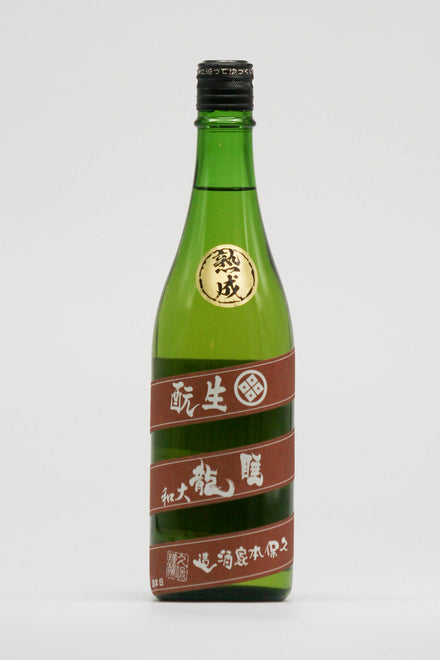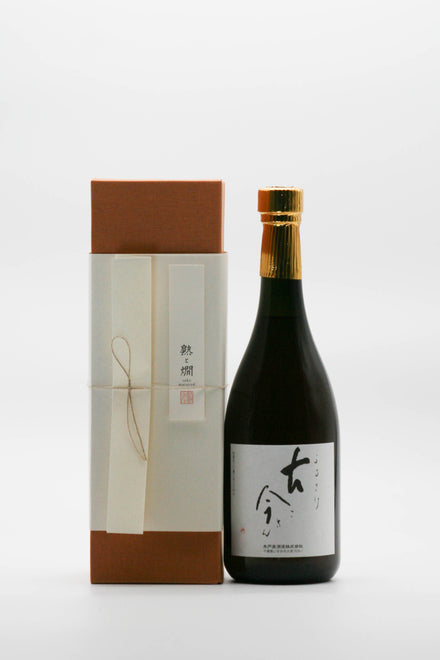
A Junmai brewed naturally using the ancient Yamahai starter method without any additional yeast and then matured at room temperature. When heated to a high temperature, it gains a richness, aroma, and gentleness, that makes it stand out.
Tamagawa Spontaneous Fermentation Junmaishu (Yamahai) “Vintage” 2018
| Vintage | 2018 |
| Years aged | 6 years |
- 2010 or later
- All Products
- Less than 5,000 yen
- Light Yellow/Green
- More attractive when warmed
- Throughout the meal
- 5-9 years
- Brewer:
- Alcohol:15 degrees or more and less than 16 degrees
- Volume:720ml
Couldn't load pickup availability
[ Drinking alcohol under the age of 20 is prohibited by law. ]
This Yamahai brewed with Kita Nishiki sake rice is the centerpiece of Tamagawa's additive-free Natural Shikomi series.
The brewery enhances the sake's color and flavor by adding water to the unprocessed sake and maturing it at room temperature for over three years.
It is characterized by a fragrance reminiscent of caramel and nuts and a pale amber color.
When heated as hot as possible, the aroma and flavor obtained through aging become clearer and more gentle.
Below is a message from the brewery.
“Yamahai's naturally brewed Junmaishu and Muroka (no added active carbon) Nama (unpasteurized) Genshu (undiluted), made with Kita Nishiki sake rice, have been our main product for many years.
Although we had high hopes for the potential of an aged pasteurized, diluted version, supply was limited due to demand for Nama Genshu sake and storage space issues.
By significantly expanding the storage space in the 2015 sake brewing year, we have facilitated a stable supply for three years. It goes well with dishes that use dashi (simmered dishes), eel kabayaki, etc. “
- about
-
Type 山廃純米 Rice polishing ratio 66% Yeast type No yeast additives Ingredients/raw materials rice, rice koji Rice type Kitanishiki Origin of rice Hyogo Prefecture (Tajima) Toji(Brew Master) philip harper Assemblage 無
- Recommended occasions/temperature
-
- How to store
-
- Delivery dates and charges
-

Tasting comments
-
Nobuhiro Ueno
(Juku to Kan Bar Master / Permanent Director of the Toki Sake Association)A mature aroma with a slightly sour taste. There is a hint of acidity in the aroma, with notes of cinnamon and chocolate.
In the mouth, sourness, astringency, and umami are in perfect order. The cacao-like scent also spreads beautifully.
The most distinctive feature of this sake is its sharpness and rhythm . It doesn't leave a strong taste in your mouth, and the clean wash makes for a uninterrupted taste experience with food.
-
Hidekazu Ishiwata
(Former National Tax Bureau Chief Appraiser)(cold)
Burnt aroma, and sweet bitter aroma like chocolate.
The taste is robust with a gentle sweetness and firm acidity.
The aftertaste is well balanced and there is a profound umami.
The best part is the profound umami.
(Warm)
Firm, mature aroma with light sulfur accents.
The higher the temperature, the clearer the outline.
There is a lingering umami. The best part is the contour that changes as the temperature is raised. -
Akiko Toda
(Director of ITTEKI, Japan Sake and Meat Research Institute)(cold)
Aroma of caramelized nuts and straw.
In the mouth, more natural notes melt into the mix.
You will want to drink many glasses at room temperature or hot. Match it with Chinese and herbal dishes.
(Warm)
When heated to 70 degrees Celsius, it becomes fuller and more balanced. -
Yuji Yamauchi
(Yushima Tenjinshita Sushi Hatsu 4th generation / 1st JSA SAKE DIPLOMA competition winner)(cold)
The sake is supported by an assertive acidity that ensures the directionality of the aroma as well as the savory flavor.
The smoothness of the sake keeps it cohesive on the palate, and the acidity, which is well pronounced, is present without ruining the balance. A sake that is not overbearing, but makes a strong statement.
(warm).
The aroma is deep and complex, like blue cheese, and the flavor has a nice sharpness. The rice and savory notes in the second half are also enjoyable.
As the temperature is lowered from 21℃, the ricey notes fade, and the sake becomes more elegant. Do not miss this opportunity to really experience this different profile.
Brewer
- Choosing a selection results in a full page refresh.
- Opens in a new window.



